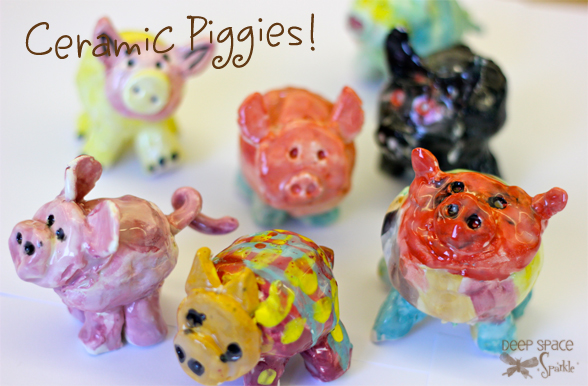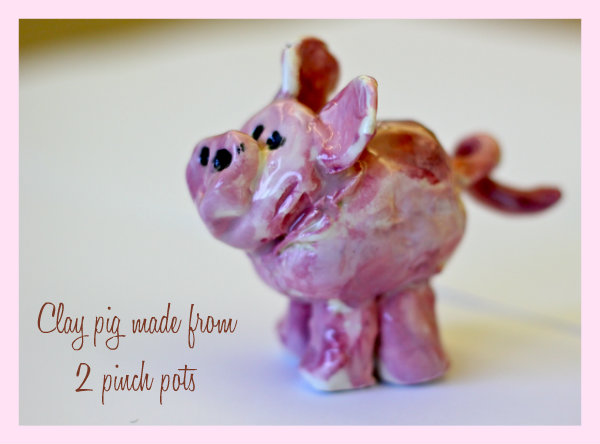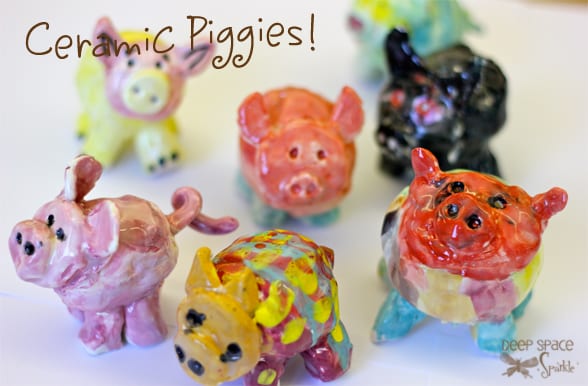
It’s never to early to teach little children how to make a basic pinch pot because when they master one, they can make just about anything in ceramics. This little pig is two pinch pots scored together, with added legs, head, snout and in this case, a curly tail.
How to make a pinch pot
Start with a ball of clay about the size of a golf ball. Push thumb into the ball to make a hole. With a pinching motion, begin shaping the hole to create sides. Be careful to show the children that pinching just the top of the pot results in very thin sides. They must pinch near the base as well.
How to make a hollow ball

Make two pinch pots and then tap their openings onto the table. This helps flatten the tops so when you “scratch-attach” the two tops together, they stick well. Use a bit of water to moisten the clay and then use a plastic knife or clay tool to smooth the edges together. The resulting shape should be a hollow ball.
How to make a pig
Now that you have a hollow form, it’s important to provide an air hole. Stick a needle tool or some other small object into the form so that air can escape while in the kiln. Take a small wad of clay and form into a small ball. Flatten this ball into a small cookie. This is the head. Add another similar shape, but smaller, for the nose. Remember when you attach tow pieces of clay, you must provide a good seal.To make the ears, create one more small ball, flatten it and cut in half. The two ears can be shaped first and then stuck to the head. Legs are 4 small rectangles rounded to form cylinders. Scratch-attach to body. The tail is slightly more difficult. Making the tail isn’t so hard but in order to attach it, you must create a hole in which it can be stuck into. A little “slip” (dried up clay mixed with a bit of white vinegar and water to form a soupy mess) creates the much needed glue.
Under-glazing and Glazing
These little guys need to dry completely for 7-1o days. Fire to cone 05 and then paint with underglaze. I dip the pieces into Duncan Dipping glaze and then fire again to cone 04.
Making ceramic pieces requires more work than just about anything else, but who can resist these cute little guys? Worth it for sure!
Download this free lesson guide on our Chicken Little template for more farm animal art inspiration!














Patty these are adorable!
I have a question about the pink underglaze you used. I have had a devil of a time finding a decent pink. I have tried various brands and shades of pink….never satisfied. What brand and color name is on your pink pig in the main photo? It looks like the best pink I have seen so far! Thanks!
Enjoy!
I do have a “rose” underglaze but for this pink, children mixed white with red and possibly a crimson underglaze together. They mixed right on the pig. We just experimented as you can’t really tell what the color will look like until after firing with glaze.
Thanks Patty. What manufacturer do you use for underglaze?
I have been mixing as well, but it just seems like there is not a true bright pink out there!
I saw a video clip recently of a piece of broken, fully dried, greenware that was painted with vinegar slip and the pieces were placed back together and you could see the vinegar visably bubbling and when the artist let go, the pieces stayed together. It was really interesting to see the chemicals in action!
I use Laguna. Love their stuff.
I’ve never heard of vinegar in slip before!! I just use water and clay. Does it help? What is the purpose, what does it do? I love learning new things!
Yes, vinegar helps. It breaks down the clay so if you have lumps, they will dissolve faster. Some art teachers apply vinegar directly to bisque to repair broken pieces but I haven’t found that to be overwhelmingly successful. The slip with the vinegar has better viscosity.
If I am understanding correctly, you are using the vinegar slip both to attach pieces of clay together and to repair broken bisque pieces? After a repair do you have to bisque fire it again or can the kids apply glaze directly over the repaired spot and then you can glaze fire it? What type of vinegar do you use and what is the ratio of vinegar to clay and water? It’s so kind of you to share your expertise.
I love these Patty!
Couple of questions. What grade did you make these with? And I wanted to make sure. You can put a clear glaze right on top of underglazes without firing inbetween? Also when you dip these do you submerge them all the way? How do you prevent them from sticking to the shelves of your kiln?
Hi Janice,
Q. What grade did you make these with? A. Third Grade
Q. You can put a clear glaze right on top of underglazes without firing in between? A. Yes, but just to be clear, I’m applying underglaze and glaze at the bisque stage now.
Q. Also when you dip these do you submerge them all the way? A. No because they would stick to the kiln shelf. Leave bottom of feet clear of glaze
Q. How do you prevent them from sticking to the shelves of your kiln? A. See above.
PS…my Easy Clay projects ebook might be very helpful to you…it explains all the basic stuff. Have fun!
I have a BFA in pottery, and we learned to use either clay slip or VINEGAR to put parts together.
The tutorial just gives an error message for the pinch pots tutorial
Hi Michelle, Yes that link seemed to be broken. I removed it. Thanks for letting me know!